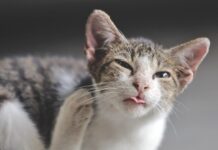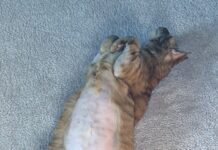A cat’s coat is his glory. Whether it’s soft, thick fur, long flowing hair or the suede-like skin of a hairless breed, the coat is more than an adornment. “The skin and hair buffer the animal from his environment — heat, cold, sun, wind — and make it more difficult for the skin to get infected,” says dermatologist William H. Miller, Jr., VMD, Medical Director of Cornell University’s Animal Hospital. “A dull, dry and unkempt coat doesn’t offer as much protection as a healthy one.”

288
The message is inescapable: Enhance the coat and you enhance your cat’s well-being. The two most important elements to consider are diet and grooming.
Quality Protein. A high-quality diet results in gleaming fur with a resilient texture. Cats are obligate carnivores, meaning that their diet must contain quality protein in the form of meat. The ideal diet is high in calories and protein. Depending on the type of food — dry or canned —protein content ranges from 34 percent to 53 percent.
Diets lacking an adequate amount of protein for hair production, growth and fat — which provides shine and aids absorption of fat-soluble vitamins — produce a dull, dry, rough coat. “A poor diet will give you a poor coat,” Dr. Miller says.
It’s debatable whether you can improve a coat by adding essential fatty acids or oils such as sunflower or safflower to the diet. High-quality commercial cat foods have all the ingredients needed for a healthy coat. Adding supplements won’t help, Dr. Miller says. They can even unbalance the diet if given in large amounts.
Sometimes the fat in the diet may be rancid or the food doesn’t contain enough protein. In these cases, supplements can correct the deficiencies, but it’s more efficient for the body and likely more cost-effective to simply upgrade the food you give.
When supplements are called for, it’s usually because the cat has a disease that must be treated with a low-fat diet or a disease that alters his ability to digest and absorb food. If so, ask your veterinarian to recommend an appropriate supplement. Store-brand products made for humans can sometimes be used; however, many of the dosages in products for humans are too high for a cat, Dr. Miller says.
Care of the Coat. Brushing and combing the fur removes dirt and loose hairs that can lead to tangles. Beneath the skin are specialized glands that produce sebum, an oily substance that protects it from moisture. Brushing helps distribute those healthy oils throughout the coat, making it shine.
Grooming is also a preventive health measure. Regular brushing or combing gives you a close-up view of the cat’s skin and coat condition, allowing you to spot the early signs of skin disease.
Cats groom themselves, using their spiked tongue to moisten fur and then lick it dry, in the process removing dirt and dead hair. Cats ingest the fur as they groom. They usually hack up the hair in the form of a hairball. (If your cat retches without producing a hairball, contact his veterinarian for treatment and ask about providing a commercial food intended to prevent hairballs.) Brushing or combing the coat helps remove fur before the cat swallows it, reducing the incidence of hairballs, a plus in any owner’s book.
Regular Brushing. A weekly brushing suits most shorthaired cats. Longhaired cats usually need more frequent attention. Some can get by with twice weekly grooming, but expect to spend at least a few minutes daily caring for longhaired breeds like Persians and Maine Coons.
Giving a cat a bath may seem contrary to all the rules of successfully living with one, but occasionally they’re necessary, although in the cat’s view that may be a matter of opinion. Cats may be bathed before shows or therapy visits to nursing homes, hospitals or other facilities. Bathing removes dander, which contributes to allergies in people. It’s also necessary if a cat has gotten into something sticky or smelly or if a cat with oily skin attracts dust and dirt. It’s not unheard of for owners to bathe cats monthly or even weekly if they’re sensitive to dander or have cats who leave oily spots on furniture or clothing.
Weekly bathing can be excessive in some cases, however, especially when humidity is low. Cats have thin skin that is easily damaged, so it’s important to use a gentle shampoo. Unless his veterinarian recommends it for a skin condition, choose one that isn’t medicated. A medicated shampoo, such as one for dandruff, is usually too harsh and may cause more problems than it solves.
“Bathing even with very mild shampoos can remove some of the surface lipid layer, which helps to waterproof the skin,” Dr. Miller says. “This waterproofing helps keep the good stuff in and prevents bad stuff from getting in. If frequent bathing is needed, the mildest shampoo should be used.”
A bath is probably necessary if an odor is present or the coat is greasy to the touch, Dr. Miller says. “If the bath removes the grease or odor, but it returns shortly afterward, the veterinarian should be consulted because the animal’s skin isn’t normal.”



